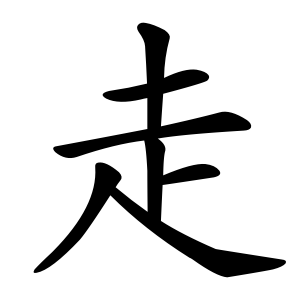走
- to run;
It signifies the action of running or moving quickly.
Etymology
走 is a phono-semantic compound formed by combining 夭, which depicts a person shaking their shoulders in motion, and 止, which represents a foot.
Besides "to run," 走 also carries meanings like "to flee," "to head towards," "to go," and "to run errands."
In Chinese, it is often used to mean "to walk" or "to go (to a destination)," and in Cantonese, it can also mean "to take away" or "to remove."
Usage in Korean
Characters with 走
10 strokes
15 strokes
Words that derived from 走
走
달릴
주
dallil
ju
Kangxi radical:156
Strokes:7
Unicode:U+8D70
Cangjie input:
- 土卜人 (GYO)
Composition:
- ⿱ 土 龰
